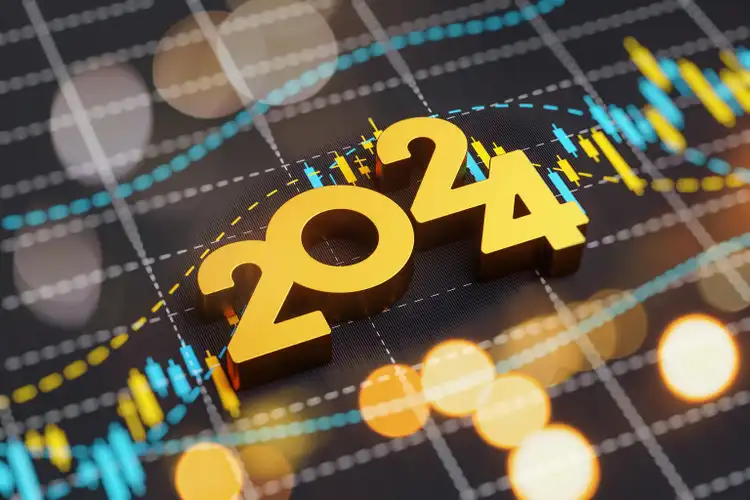Summary
- JD Henning discusses his approach to the market and emphasizes the importance of timing and using momentum gauges to avoid major market downturns.
- Investing vs trading portfolios.
- Henning advises caution in the current market and suggests focusing on value sectors and stocks.

Listen below or on the go via Apple Podcasts or Spotify.

JD Henning talks value, momentum, and combining fundamental with technical analysis (1:40). Investing vs trading portfolios (3:45). Cautious going into 2024; an unusual year for market considerations (7:50) If money flows are going out, it’s a good time to concentrate on more positive sectors (13:15).
Transcript
Rena Sherbill: JD Henning, welcome to Seeking Alpha. Welcome back to Seeking Alpha for those who read you and have heard you before. And welcome to Investing Experts. It’s great to have you back on the show.
JD Henning: Thank you, Rena. I’m really glad to be here, and I’m also excited that this is the start of my eighth year on Seeking Alpha as a contributor.
RS: Wow, that’s amazing. Do you know it’s the start of — well, I’m in the middle of my 15th year at Seeking Alpha. Isn’t that crazy?
JH: Wow, congratulations.
RS: Thank you very much. Congratulations to us both. And I think it speaks to the veracity of the community in Seeking Alpha and the strength of the investing analysis and also the power of the communal approach to investing.
And for those who didn’t listen or for those who did listen, you recently did a webinar where you really broke down your background and your strategy and your investing style and what you’re talking about and what you’re analyzing on Seeking Alpha where you run an investing group called Value & Momentum Breakouts.
But if you could synthesize for our listeners, and I would greatly encourage anyone listening to go into that, deep dive that JD gets into in the webinar, and we’ll leave a link to that in the show notes. But in any event, if you could synthesize in one line, or maybe in a couple of lines, what your approach is to the market and why that is so?
JH: I’m glad to do that. Basically, it kind of started when I was investing 35 years ago and I would follow all the buy and hold analysis and just hang in there for dear life that things would do well. And over the years I came to the conclusion, there has to be something that works a little better than buy and hold.
And I get it for the long-term, maybe 20, 30 years, things go up, but there are major downturns that we like to avoid. And so after selling my business, I went back to my doctoral studies and worked on timing indicators.
And I looked at a lot of research that was out there and started constructing my own model that I call the momentum gauges. And I’ve since automated them on a website at Value & Momentum Breakouts and I use them on the indexes as well as stocks and ETFs. And I find that the timing works a lot better for me than just buy and hold and hang in there.
RS: And what would you speak to the value by combining fundamental with technical analysis? What does that give you?
JH: Yeah, I think that gives you a really good, well-rounded approach. I also include behavioral variables. I don’t think there’s any one field of finance that has cornered the market on timing, or on market returns. And I think there’s value to be found in all the different fields and all the different approaches. And I try and leverage that.
But I also try and avoid an approach that just says, well, hang in there, you may not have made enough money this time, but if you just hold on for another year or two more years, it’ll go up. And I kind of frown on that approach. I think there are ways that you can time. There are ways that you can avoid major market downturns.
RS: And how do you feel about investing and trading?
JH: Oh, I love it. And I think those two are a little bit different. I mean, investing generally comes with a connotation of long-term accumulation and appreciation, whereas trading tends to go along with intraday traders, or short-term traders. And I do both of those in my service.
We have short-term portfolios. We have long-term buy and hold portfolios. And last year was a record year for us across all the different portfolio types that I offer. For example, our value Piotroski-Graham portfolio, it made 47.1% last year, not adjusted for dividends, which put it up to 52% returns.
We also have the Breakout MDA models that are very aggressive, very quick short-term gainers that have done exceptionally well. And last year, we had 125 picks that gained over 5% in a week. We had 65 that gained over 10%. And even just last week, we’ve had two picks that went up over 50% and as high as 87% with (SANA). And so we look for those kind of momentum things. And that kind of leads to a question that my members have been asking me, like, what are the best variables for picking stocks? And I would have to say that it matters greatly on what kind of stocks you’re after.
If you’re on to the long term, the investing approach, I would leverage the fundamental approach a little bit more heavily. If you’re into short term trading, you definitely want to look at money flows and you want to look at technicals. And to me, the strongest variable is money flow. And that comes in the form of the MFI indicator, as well as the Chaikin money flow indicator.
And those tell you if people are accumulating it or dumping the stock. And you may have a great fundamentally solid stock that’s been recommended by a lot of analysts, but if the money flows are out of that stock, you’re just not going to do well. You’re not going to see a bid on it.
And conversely, and this is why I have a strange portfolio called the negative forensic portfolio, is that there are stocks in companies that don’t have organic growth or really good earnings, but yet they see very high net inflows. And those portfolios can really outperform. And so again, it’s looking at the right variables and sometimes trading off between technical, behavioral and fundamental variables to get the kind of results you’re looking for.
RS: And would you say that investing and trading depends upon an investor’s risk profile, or time in the market, or timeline in the market? Or does it have to do more with their risk appetite?
JH: Yeah, absolutely. I think it goes across all of those factors. I think you can do both. I think an investor can be a trader. I have long-term portfolios for college funds and other long-term investments, but I also do short-term trading. I also trade in ETF portfolios that — we have an active ETF portfolio that gained 64% last year.
And even in 2022, we got 17% returns with bear funds as the market was going down. So I think a person can be both. I think we can scale back and forth towards more of a trader and more as an investor. And in this current market, I think it’s good to use timing indicators, short and long-term to be aware of what’s coming and not to be overly aggressive.
RS: There’s been some nice highlights of the market for any investors paying attention. There’s some nice things to pick apart. What would you say you’re looking at the market? It’s the middle of January 2024. How are you looking at things? How are you understanding them?
When you let it sit a little bit, how are you digesting that and then looking ahead to the weeks and the months coming up?
JH: Yeah, that’s a really good question. There’s a lot of factors and variables to consider. Just starting at the cyclical level, people like the patterns and the cycles. And January tends to be a very positive month going back to 1928. On average, it’s one of the better months of the year.
However, February on a cyclical basis is the second most negative month of the year. And so a lot of times people are taking profits towards the end of January. We also happen to be in an election year, and that also adds to some of the variability in the monthly cycle returns. And what we see is that February is three times worse in an election year than it is on the average going back to 1928.
So I do expect to see a little bit of a pullback in the short term. Longer term election years do tend to be positive. There are some rallies ahead of the voting in November, things to look for later on in the year. The summer rallies are pretty strong in election years. And that’s the cyclical side.
But the other side of it is, in 2024, there are things happening that we have not seen in decades. One is we have the largest ongoing quantitative tightening program from the Federal Reserve that we’ve seen — ever seen, and combined with the highest interest rates, Fed funds rates in 22 years.
So that makes it an unusual year for market considerations. And looking back at all the hiking cycles that we’ve seen, it isn’t the hiking that leads to a market downturn, but it’s the period of time when the Federal Reserve keeps the rates higher for longer that has led to market corrections every single time after a rise in the Fed funds rate.
So, I’m a little cautious going into this year. I also noticed that Warren Buffett’s Berkshire Hathaway (BRK.A) (BRK.B) took off $157 billion in holdings and moved it into cash. I believe that’s the highest cash holdings they’ve ever had. And they did that back in the fourth quarter. That tells me that we might be nearing a peaking cycle.
Even though Warren is famous for not being a market timer. They did come out and say, they’re just not seeing value and they’re going to wait until things become a little bit better valued later on in the year, which generally means they’re looking for a pullback. And I think certain segments of the market have just gotten too far too fast and we see this volatility.
And then lastly, the thing to consider is that we rarely ever see market leaders from the prior year be market leaders for the coming year. And by that, I look at the Magnificent Seven that have, over the past two years, they’re back to where they were in 2022 at the peak and they had quite the ride.
We see a lot of great numbers from NVIDIA (NVDA), but investors often forget that last year it lost 67% from the peak. And those kinds of rides can show up again. They’re not just one-time events and people take profits and momentum works in both directions.
So I would encourage people to be a little bit cautious for 2024. I do like value sectors and stocks. The portfolio for Piotroski-Graham is consistently beating the markets. It was positive again through 2022 in the biggest downturn. And it’s been positive every year since I’ve been sharing it on Seeking Alpha.
So I would look to be a little bit more cautious about growth stocks and some of these technology sectors that have really gone high on the AI exuberance. Not to say that they can’t continue higher, but they’ve just gone a little bit too much. And that could be consistent with a February pullback like the cyclical patterns.
So those are some of the things and another indicator that I think is really substantial for 2024 are the long-term bond funds. If you look at (TMF), I would encourage listeners to take a look at that chart and just look at the amazing similarities to 2022.
It bottomed in October of 2022, just like it bottomed in October of last year. It rallied through December and it’s starting to taper off in January towards another potential pullback. I think those kind of cycles are remarkable and a lot of technical investors are following those kind of signals. So it can be a self-fulfilling indicator and something that people should be aware of.
RS: And if you could break it down even further, if you’re coming at it from, I mean, the podcast is called Investing Experts. So clearly we’re more focused on the investing side of things than the trading side. But I think it might behoove listeners to hear maybe a further breakdown if you would between how an investor is looking at these next couple of months, or month vis-a-vis ETFs, stocks and sectors between investors and traders.
JH: Yeah, well, I encourage my traders to go look at my weekly MDA breakout picks. We also have a bounce lag model. They’ve just done extremely well.
It’s an acronym for multiple discriminant analysis, which is just like you mentioned in about my last webcast, I got into more detail on how that’s set up. But basically it’s drawing from all the different fields of finance to find some of the strongest variables and those weekly picks are really good for the traders.
Last week, we saw peak returns of 40.9%. They closed up 22%. And we’ve had multiple weeks of over double-digit returns in weekly with a lot of breakout picks. For the investors, I look at the value portfolios that I set up, as well as we have actively traded portfolios, ETFs and stocks. And those I kind of use the momentum gauge timing, so that we don’t get major downturns if we see the signals turning more negative.
So to put it in context, we saw a very strong rise from November and we also had a positive signal on the momentum gauges from November. And so that would be good for traders and investors to load up. But as we’re approaching the middle of January, we’re starting to see four sectors have turned negative. We’re starting to see more market outflows. And it’s a lot of choppiness like we saw at the end of 2021 and the beginning of 2022.
And I never know what the future holds, but I do know that if the money flows are going out, it’s a good time to be a little bit more cautious and concentrate on the more positive sectors. So for investors, I would say longer term, I like some of the energy plays, especially natural gas is extremely low right now.
I like the shippers. They’re also benefiting from a lot of the disturbances in the Red Sea area that has really increased the cost and in a sense the revenue for those shipping companies. We hold many of those in the value portfolio of the Piotroski-Graham. They were already good value prior to some of these incidents in the Middle East and this may just further increase the inflows and make them more like breakout stocks.
We saw that with (TNK), which was also a breakout stock that did very well and there’s others. Members don’t like me to give away picks and we have a whole new set for next week. But anybody listening can dial in with a free trial and see what we have in store for next week.
So that’s kind of how I do it. I just have a portfolio spread that goes from short-term breakout to long-term buy and hold. But the longer you stay with me, the more likely you are to follow the gauges. And it gets harder for people to be a buy and hold investor if they can avoid market downturns.
RS: And then in terms of kind of how you break down sector and stock, is it something that you’re following in the charts sector wide? And then you have a few specific stocks that you’re looking at within those sectors and then you follow that. Are there stocks that surprise you along the way? How are you looking at surprise sectors in addition to that?
JH: Yes. Well, there’s a lot I can say on that. That’s a good question. I started out analyzing 7,500 stocks across the whole market to do the momentum gauges. And then I quickly realized, well, we got indices that have different weightings on different stocks. The major indices that people follow only look at 630 stocks out of 7,500, and so that distorts people’s idea of market performance.
Then I looked at the sectors and then you have, within the sectors, you have industries and then there’s — I think there’s around 175 industries. And so what I tend to do is encourage people to look at what’s the overall market condition? Should I even be risking my money right now? Then I say, look at the sector gauges, look at where the money flows are going in the sector level.
And then to your question, I would say, look at the industry level, you know, just one of the complicated industries or sectors is basic materials, because you have things in there like gold and coal and paper and lumber and agricultural chemicals. And they’re not all related, but they form that whole sector and it can be distorted by one commodity over another.
So sometimes you really have to dial down and look at the industry level. And then within the industry, I use the same modeling to find what are the good stocks in that industry and see if that will continue into the next week.
And kind of related to that, you know, I’m heavily into natural gas right now with (BOIL). It’s a 2X energy Nat Gas Bull Fund. And that’s up over 10% for the year, just starting out. We’ll see how it does. But it has a good price target or resistance around $50 a share, which is close to a 37% increase from here maybe in the short to middle term for 2024.
But I don’t know the future, so I can’t say you should definitely hold it for the year. And I never make that kind of recommendation. I look at the signals, I look at changes in the money flow, and there are many factors that will affect price.
RS: We’ve heard Rob Isbitts on the show talking about the high number and the growing number of ETFs in the market. What are your thoughts on that?
JH: Yeah, that’s an interesting trend. And we often hear that trend debated about passive versus active fund investing and things like that.
My concern with it is that especially after a very good year that we had last year with high concentration in the Magnificent 7, that lifted the major indices, even if the rest of the market didn’t participate as much last year, it gives people a false sense of security that they can just put a lot of money into passive investing and they’ll be fine.
The reason I say that is it creates a hurting behavior. And these fund managers, they’re obligated to put the money into these passive funds right into the stocks that they promised to put them in. So they’re not looking at the fundamentals and they’re not looking at a lot of the earnings. They’re just committed to doing what those funds say they’re going to do.
And that creates a large distortion. It makes some of the mega caps a little bit more risky for me, even though they have phenomenal earnings and growth potential. They can’t get overpriced relative to the rest of the market. And I think that makes an opportunity for value stocks. It makes an opportunity for small caps for 2024.
But I would just be careful with the passive funds. Certainly active funds come with plenty of risk and the creation of all of these ETFs with the new Bitcoin ETFs and the excitement with more fun flows going to the Bitcoin. That’s a great example of fund flow, you know, watching where the money goes is a very strong indicator and one that Peter Lynch relied on regularly.
And I’m a proponent of money flow and many other non-price variables that support the growth. I would just be careful that ETFs are creating a high concentration in some stocks that really shouldn’t be priced at those levels.
RS: What do you think comes of the Bitcoin ETF stories?
JH: Well, I think it can attract a lot more money. I don’t know what the future of Bitcoin will be, but I know that there’s a lot of applications. And certainly, the government is very interested in taking over some of those applications and applying them to taxpayers and asset holders as an easier way to manage money supply and other things.
So it can have some very good advantages. It can cause some problems. But in the short-term, I think there’s an exuberance there that’s going to cause a lot of large inflows. And I’m, you know, I’m for it. When it comes to investing or trading, it doesn’t really matter what the underlying security is.
As long as people are willing to buy it and keep pushing up the price, you’re going to see price appreciation. And it doesn’t have to make a whole lot of sense. And oftentimes it doesn’t. We saw that with the GameStop phenomenon and (AMC) squeezes. But as long as the money flows are there, you’re going to see gains.
RS: And any thoughts on the ARK ETF (ARKW) kind of playing around in that part of the market?
JH: My understanding is they were one of 11 funds that got approved for Bitcoin trading and they were, I thought they were the first or the premier of the Bitcoin fund. I really don’t know any more detail about how they’re going to allocate it or what other funds might – what other coins or crypto may be involved in that.
I would just go to good resources like ETF.com and read up on how they, what their rules are for their fund managers. I’ve seen many times, especially like in the energy sector where you have a hundred different funds that perform very differently on the oil — on the crude oil index. And it’s all about how those corporate fund managers decide to allocate their money. So I would just be cautious and maybe pick up two or three different ETF funds if you’re interested in that area.
RS: And what are your thoughts on the Fed’s approach to the market, even as just a market participant or that’s been one for as many years as you have and that’s seen the cycles. What are your thoughts on how the Fed’s approaching things?
JH: Well, that’s another good question. And I get a little bit frustrated with the Fed’s frequent intervention that tends to distort prices and markets. I like to just kind of let things go as they are and be a free market trader as much as possible.
It’s really hard to guess the Fed’s next move, but they have been telegraphing for a long time that they were raising rates. And then they claim rate cuts are coming, but I don’t know that they’re going to hit their timeline with that. And I think the market is already priced in quite a few rate cuts for 2024.
I think the exuberance is always high and strong from the January effect. And as we get into February and March, I think some investors may be disappointed again in the Fed and that their promises aren’t happening as quickly as they’d like.
It’s very hard for the Fed to keep interest rates at these levels. And I do expect that they’re going to have to cut, but I don’t know if they can really hit their schedule. So that throws another major variable in and it’s very hard to predict markets. And if you see fund flows changing, which I think they will change very soon, it’s good to adjust to that as well.
RS: And do you have thoughts on the macro picture in terms of — do you have an eye towards, is a recession coming, where are we at in the inflation cycle? Does that play a big part for you in how you’re looking at the investment landscape?
JH: I don’t know whether the recession is coming or it’s a hard landing or soft landing, but I do know that the M2 money supply is coming way down. I know that the Fed is in a tightening sequence that’s adverse to markets. I know that buybacks — corporate buybacks, which are a major inflow activity are way off their highs from last year. They came up a little bit in the fourth quarter, but not really a strong inflow to market.
So I’m kind of seeing what Warren Buffett is seeing where the value is not as good as it was. And some things are extremely elevated for risk of a downside. I don’t know that that will necessarily lead to a recession, because there’s always good opportunities in the market.
But I think it’s going to create a change in investing style for this year. And I think a lot more people are going to head to value sectors and segments and look for stocks that really deserve to be priced a lot higher.
RS: And would you say, because we’ve had – KCI Research was on here recently saying the same thing about value. Would you combine the technical and fundamental reasons behind that preference or that kind of prediction?
JH: Absolutely. I would use every stream of finance to support the value proposition. Value is also consistently good over the long term. It’s just some years it’s harder to find value than other years. And it’s a good stable approach. It’s not always fancy or exciting, but it can give you some really good solid returns.
Last year, like I said, our value portfolio made 47.1% plus adjusted dividends, made 52%. And that was part of just the excitement and the exuberance and the inflows of the market, especially from the November positive signal on the gauges. We saw a very large amount of inflows to the market. So I would say, value is always your safe bet. It may not be the top performing segment in the year, but it usually outperforms riskier segments in the long term.
RS: And what would investors be looking at when it’s time to switch out of value or what’s something that happens in the market that would push an investor to want to look elsewhere?
JH: I think one of the areas you would look for is some of the growth sectors to start showing large signs of profit taking. And when valuations get too high for some of the technology stocks or sectors that have really run up, we’ll see a little bit of a pullback and that will be a boost for value. That’s one good indicator.
The other, of course, is inflows to value stocks, and we’re already seeing some of that now. Yes, and again, on the short term you can always find breakout stocks in a lot of different sectors.
So it’s — there’s timing involved. It’s really important, I think. And I think some of my members agree to look at the momentum gauges and see what’s hot and see what’s losing and then adjust your portfolio accordingly. We’ve shown that over the last now going into eight years that these portfolios have outperformed the S&P 500 every year.
RS: What do you think — when you’re looking at market headlines or market narratives, what do you think investors are getting wrong now or generally get wrong?
JH: Well, I try not to look at market headlines unless they’re like an event in the Red Sea or something significant that’s changing policy or OPEC decision. There’s a lot of noise out there. And I used to follow a lot of noise for the last 20 or so years of investing. And I realized that it’s much more important to see where the money goes and see what the fundamental and the technical variables are telling you, then you hear what people think may be happening or what could happen or the next great thing that’s coming along.
It can tip you off to ideas, but it’s really important to go and explore them with more data.
RS: What’s your favorite data point?
JH: Well, I probably touched on it with Money Flow, but I think what’s even stronger is the combination of these variables. And that’s what my whole doctoral research was based upon.
It’s not any one variable that will be the most reliable, but over time it will be the combination of them. And using it from different fields of finance. And that’s where I combine them into the automated gauges that I’ve developed for my subscribers.
RS: Anything to say about another sector in the market that you’re looking at or that is interesting for investors to think about?
JH: Yes, I think biotech has really been beaten down hard and there’s some good breakout stocks in that sector. Healthcare is starting to improve again. They’re not seeing the same amount of fund flows that they saw during the COVID period, but there’s a lot of great potential and some great developments.
And frankly, the United States has some of the best biotech and healthcare developments in the world. And that’s always a great field to be looking at. There’s opportunities there.
RS: Speaking of growth and value in biotech, do you keep an eye towards the psychedelic developments in biotech?
JH: I don’t really look at it that closely. I do see like the cannabis sector is taking off again and there’s some discussion that cannabis will be moved to a schedule 3 drug, which could open up more development and opportunity for some of those healthcare biotechs that are in that field.
And I saw increasing money flows in that direction as well. So that’s a fun field with a lot of speculation and volatility. You can do very well, especially if the policy changes in favor of cannabis.
RS: So is it catalyst based a little bit when you’re getting into the growth, when you’re dipping toes into growth sectors?
JH: It can be. It has a lot to do with what creates the money inflows. Like I said, there’s stocks that have terrible fundamentals, but if they have an attractive catalyst, whether it’s a government policy change or even terrorists in the Red Sea that are driving up prices, it can create an opportunity for pricing that you wouldn’t ordinarily expect.
RS: And would you say that’s more geared toward trading?
JH: Yes, usually you’d expect those events to not last very long. Policy changes can last a while, but most of the benefits to policy changes and adverse situations are short lived. And so, those would be typical of maybe two to three week periods, depending on the size of the fund flows.
RS: When you’re looking at the cannabis market, is it short term that you see now or are you looking at maybe there’s value within a growth sector?
JH: Yes, it can be both. What I see for certain charts, if you look at the, like, (MJ) ETF for cannabis, you see that it has a lot of spikes and then rapid pullbacks. And that’s sort of indicative of speculators that load up on expectations and then often are disappointed and then sell out rapidly. So you want to kind of avoid those kind of risks, or scale into them in a level that you can handle. But you do see longer growth opportunities.
(CURE) for healthcare has been doing well coming off of November lows. I think healthcare can do some solid returns for the year. And that would encompass biotechs and cannabis and other kinds of drug trades.
RS: Very good. JD, anything else that you think we left out or that you would like to share with listeners?
JH: I would just say that if they check out my service in my automated website, Value & Momentum Breakouts, you can see all these things visually that give you a real clear sense of what these variables are telling us. And there’s only so much that I can look at during the day, but with indicators, you can scan a lot more data more quickly.
RS: Really happy to have you on today, JD. Look forward to the next time. Encourage people listening to check out your services on Seeking Alpha and elsewhere. Really appreciate you coming on today JD. Thank you again.
JH: Thank you, Rena. I really appreciate it.







